By John Treadwell Dunbar ——Bio and Archives--March 17, 2011
Travel | CFP Comments | Reader Friendly | Subscribe | Email Us
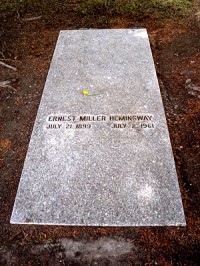 Nobel laureate Ernest Hemingway chose well when he bought a home outside Ketchum in Sun Valley in 1959, abandoning his beloved Cuba to Castro, along with 6,000 books, his motorboat the Pilar, the Finca Vigia and the sparkling blue Caribbean that ran warm and salty through his veins. A world traveler with discriminating tastes in the arts and the natural order, a rugged, brawling bookworm of a man drawn to high country his entire life, the aging Hemingway with his white beard and arsenal of firearms picked Idaho's Ketchum and Sun Valley in the end, and for good reason.
Our literary genius of world-renown might have been plagued by a serious drinking problem and rapidly degenerating health, mental and physical, but he had enough sense to recognize the unique quality of this place. When Hemingway first set eyes on the land back in the 1930s it was little more than an outpost for the hardy tucked into the rugged fold of mountains extraordinaire boasting green meadows and deep forests that define the elevated, an alpine country awash in fresh air and dry sunshine and wild landscapes that continue to beckon - the beauty of it all.
Nobel laureate Ernest Hemingway chose well when he bought a home outside Ketchum in Sun Valley in 1959, abandoning his beloved Cuba to Castro, along with 6,000 books, his motorboat the Pilar, the Finca Vigia and the sparkling blue Caribbean that ran warm and salty through his veins. A world traveler with discriminating tastes in the arts and the natural order, a rugged, brawling bookworm of a man drawn to high country his entire life, the aging Hemingway with his white beard and arsenal of firearms picked Idaho's Ketchum and Sun Valley in the end, and for good reason.
Our literary genius of world-renown might have been plagued by a serious drinking problem and rapidly degenerating health, mental and physical, but he had enough sense to recognize the unique quality of this place. When Hemingway first set eyes on the land back in the 1930s it was little more than an outpost for the hardy tucked into the rugged fold of mountains extraordinaire boasting green meadows and deep forests that define the elevated, an alpine country awash in fresh air and dry sunshine and wild landscapes that continue to beckon - the beauty of it all.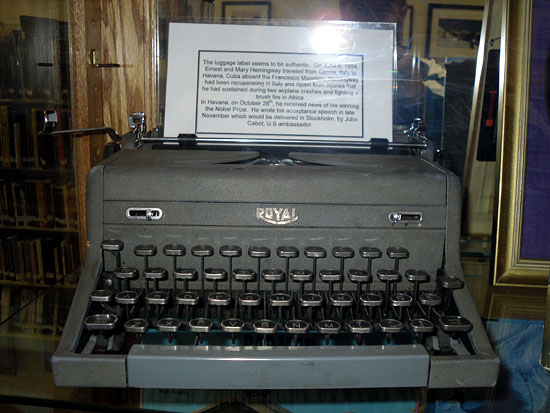 Wedged between the northern rim of the Great Desert Basin and the southern terminus of central Idaho's mountain kingdom, greater Sun Valley encompasses the resort community of Sun Valley and the gentrified, glitzified old mining town of Ketchum clustered a mile away at the base of groomed and manicured Bald Mountain (9,150'), or as local skiers simply call it, Baldy.
The best of Highway 75 stretches 60 miles from Hailey through Ketchum in a northerly direction over Galena Summit (8,700') to the quaint and popular old mining town called Stanley where log buildings dominate. The corridor bisects six impressive mountain ranges. The Soldier, Smoky and spectacularly craggy Sawtooth Mountains are to the west, while the Pioneer, Boulder and White Cloud Mountains lie to the east. Much of the land north of Sun Valley is federally designated wilderness, and 778,000 acres are part and parcel of the Sawtooth National Recreation Area (SNRA).
Wedged between the northern rim of the Great Desert Basin and the southern terminus of central Idaho's mountain kingdom, greater Sun Valley encompasses the resort community of Sun Valley and the gentrified, glitzified old mining town of Ketchum clustered a mile away at the base of groomed and manicured Bald Mountain (9,150'), or as local skiers simply call it, Baldy.
The best of Highway 75 stretches 60 miles from Hailey through Ketchum in a northerly direction over Galena Summit (8,700') to the quaint and popular old mining town called Stanley where log buildings dominate. The corridor bisects six impressive mountain ranges. The Soldier, Smoky and spectacularly craggy Sawtooth Mountains are to the west, while the Pioneer, Boulder and White Cloud Mountains lie to the east. Much of the land north of Sun Valley is federally designated wilderness, and 778,000 acres are part and parcel of the Sawtooth National Recreation Area (SNRA).
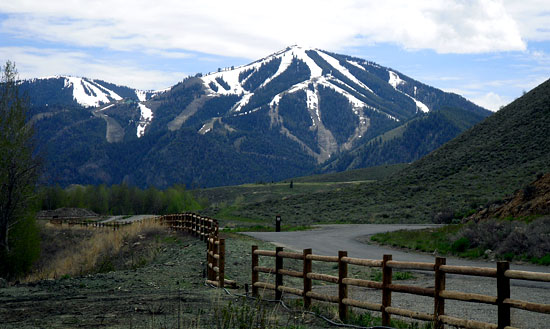 The land is a wonder-world of high alpine lakes, hidden basins, rocky ridges, evergreen forests and endless mountain vistas that are guaranteed to shock and awe. Whether backpacking, hiking, mountain biking, climbing, horseback riding, boating, snowmobiling, fishing, four-wheeling, hunting or just killing leisure time in the RV, Sun Valley's mountains are actually worthy of the overused phrase "recreational paradise."
Reminiscent of the Colorado Rockies, these rugged peaks are similarly accessible due in large part to a strong mining tradition that built the roads and roadways one finds today. Branching off the main highway and extending back through deep canyons and hidden valleys, many dirt roads are calling. But beware as some require a high-clearance, four-wheel-drive vehicle and proper back country know-how. It's wild country out there with long distances fraught with potential obstacles.
The land is a wonder-world of high alpine lakes, hidden basins, rocky ridges, evergreen forests and endless mountain vistas that are guaranteed to shock and awe. Whether backpacking, hiking, mountain biking, climbing, horseback riding, boating, snowmobiling, fishing, four-wheeling, hunting or just killing leisure time in the RV, Sun Valley's mountains are actually worthy of the overused phrase "recreational paradise."
Reminiscent of the Colorado Rockies, these rugged peaks are similarly accessible due in large part to a strong mining tradition that built the roads and roadways one finds today. Branching off the main highway and extending back through deep canyons and hidden valleys, many dirt roads are calling. But beware as some require a high-clearance, four-wheel-drive vehicle and proper back country know-how. It's wild country out there with long distances fraught with potential obstacles.
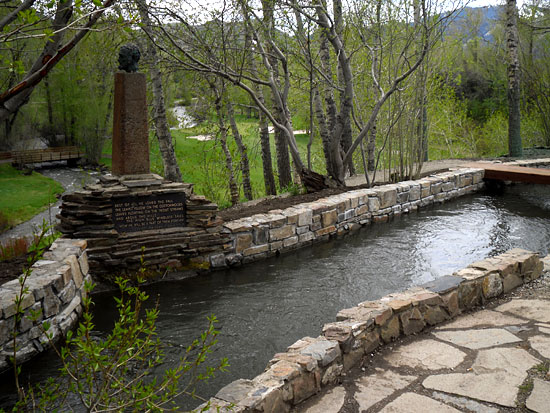 With 2,054 acres, 70 runs and a 3,400-foot vertical drop, Bald Mountain's 13 lifts and the new Roundhouse Gondola have some calling it the "best single ski mountain in the world." A lack of wind, lift lines and a significant amount of constant pitch terrain lends credence to this claim to fame, but calling it the very best, though possible, is a tall order. I don't know as I've never skied this particular mountain so I better keep my mouth shut. Ask the most famous ski filmmaker and producer in the world, Warren Miller, who got his start here in the 40s as a preeminent ski bum with a vision that fostered an entire industry of like-minded filmmakers. He'll know, and he comes back now and then.
The need for a Nordic, or cross-country, ski fix is readily cured by the abundance of Nordic track. The Galena Lodge area north of Ketchum offers 100 miles of trails, while the Wood River Valley's system connects the valley's communities with 20 miles of easily accessible slipping and sliding. And if that isn't enough, more trails are offered at the Sun Valley Nordic and Snowshoe Center.
With 2,054 acres, 70 runs and a 3,400-foot vertical drop, Bald Mountain's 13 lifts and the new Roundhouse Gondola have some calling it the "best single ski mountain in the world." A lack of wind, lift lines and a significant amount of constant pitch terrain lends credence to this claim to fame, but calling it the very best, though possible, is a tall order. I don't know as I've never skied this particular mountain so I better keep my mouth shut. Ask the most famous ski filmmaker and producer in the world, Warren Miller, who got his start here in the 40s as a preeminent ski bum with a vision that fostered an entire industry of like-minded filmmakers. He'll know, and he comes back now and then.
The need for a Nordic, or cross-country, ski fix is readily cured by the abundance of Nordic track. The Galena Lodge area north of Ketchum offers 100 miles of trails, while the Wood River Valley's system connects the valley's communities with 20 miles of easily accessible slipping and sliding. And if that isn't enough, more trails are offered at the Sun Valley Nordic and Snowshoe Center.
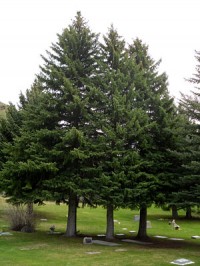 Looking down from a safe distance I'd say Ketchum/Sun Valley is basically rich, white and crawling with beautiful people who've turned this diamond in the rough into their own personal playground. Fortunately, there's plenty of ugly folk to keep it grounded. All in all it's sanitized, upscale, orderly, architecturally stunning, classy and I love it, even though large banks have gobbled up the little shops and hangouts that gave Ketchum its laid-back mountain vibe that enticed converts in the first place.
You get a sense of lurking opulence while driving by the airport 15 miles south of Ketchum where a flock of Learjets and Gulfstreams are frequently corralled on the south tarmac waiting to whisk their owners back to the big city after a three-day orgy of rest and relaxation at their quaint five-million-dollar cottages that are probably drowning underwater in a market now moving as slow as molasses compared to the heady days of 2006.
I'm not complaining and I most certainly am not envious of those hefty payments. I love beautiful luxury homes, fine architecture, expert craftsmanship and exquisite design, and with firsthand knowledge of their construction I greatly appreciate the sweat and blood with which they are built, so many pieces, so much complexity.
Flipping through a copy of the Sun Valley Western Home Journal available at the local visitors center provides the inquisitive a sneak peek into these beautiful homes that sit empty months on end, monstrous masterpieces of mind numbing proportions. It's the epitome of perfection and all those other words that attempt to capture the best of the architecturally best.
Looking down from a safe distance I'd say Ketchum/Sun Valley is basically rich, white and crawling with beautiful people who've turned this diamond in the rough into their own personal playground. Fortunately, there's plenty of ugly folk to keep it grounded. All in all it's sanitized, upscale, orderly, architecturally stunning, classy and I love it, even though large banks have gobbled up the little shops and hangouts that gave Ketchum its laid-back mountain vibe that enticed converts in the first place.
You get a sense of lurking opulence while driving by the airport 15 miles south of Ketchum where a flock of Learjets and Gulfstreams are frequently corralled on the south tarmac waiting to whisk their owners back to the big city after a three-day orgy of rest and relaxation at their quaint five-million-dollar cottages that are probably drowning underwater in a market now moving as slow as molasses compared to the heady days of 2006.
I'm not complaining and I most certainly am not envious of those hefty payments. I love beautiful luxury homes, fine architecture, expert craftsmanship and exquisite design, and with firsthand knowledge of their construction I greatly appreciate the sweat and blood with which they are built, so many pieces, so much complexity.
Flipping through a copy of the Sun Valley Western Home Journal available at the local visitors center provides the inquisitive a sneak peek into these beautiful homes that sit empty months on end, monstrous masterpieces of mind numbing proportions. It's the epitome of perfection and all those other words that attempt to capture the best of the architecturally best.
 Ketchum and Sun Valley might be remote and lacking in box store shopping, but culturally it's rich and vibrant because the haves, and a few nots, shall not be denied. Art galleries, opera and free symphonic concerts, dance performances and lectures for the intelligentsia, film festivals and writers conferences, you'll find all of that here and more.
When it comes to the local art scene, Art Ltd. Magazine put it best: "At an elevation of 5,945 feet, the air in Sun Valley is rarefied - and so is the clientele of the area's top-flight art galleries. Serving the valley's plethora of well-heeled and well-educated art collectors are art galleries that could hold their own in Manhattan, Berlin, London or Los Angeles."
Hemingway wouldn't have anything to do with the place today. He loved skiing and loved fine art to a point, mind you, spending hours at the Prado gazing, but that wouldn't be enough to keep him here among the jet-set and their ilk. He'd be up in Alaska fishing halibut from his boat out of Cordova, or buzzing the Interior in his floatplane, hunting browny and reeling in kings and silvers and dreaming up fodder for his next great novel, replenishing the well, as he put it.
And if he didn't, if he was dressed in spandex pedaling his bicycle down Sun Valley's many paved bike paths sucking on his camelback or showing off his gilded log mansion to the droolers, he wouldn't be Ernest Hemingway. There was too much dirt under his fingernails.
Ketchum and Sun Valley might be remote and lacking in box store shopping, but culturally it's rich and vibrant because the haves, and a few nots, shall not be denied. Art galleries, opera and free symphonic concerts, dance performances and lectures for the intelligentsia, film festivals and writers conferences, you'll find all of that here and more.
When it comes to the local art scene, Art Ltd. Magazine put it best: "At an elevation of 5,945 feet, the air in Sun Valley is rarefied - and so is the clientele of the area's top-flight art galleries. Serving the valley's plethora of well-heeled and well-educated art collectors are art galleries that could hold their own in Manhattan, Berlin, London or Los Angeles."
Hemingway wouldn't have anything to do with the place today. He loved skiing and loved fine art to a point, mind you, spending hours at the Prado gazing, but that wouldn't be enough to keep him here among the jet-set and their ilk. He'd be up in Alaska fishing halibut from his boat out of Cordova, or buzzing the Interior in his floatplane, hunting browny and reeling in kings and silvers and dreaming up fodder for his next great novel, replenishing the well, as he put it.
And if he didn't, if he was dressed in spandex pedaling his bicycle down Sun Valley's many paved bike paths sucking on his camelback or showing off his gilded log mansion to the droolers, he wouldn't be Ernest Hemingway. There was too much dirt under his fingernails.
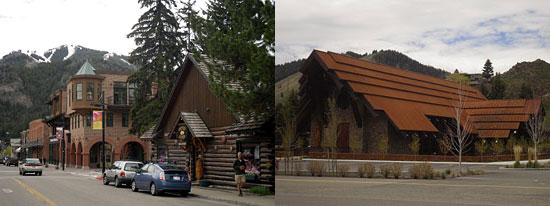 I often wonder if Hemingway would have been as lauded had he not taken his own life. Who knows, although it doesn't really matter in the long run because it's about his words, the sentences and paragraphs and images and understatement and insight and that clunky but highly effective dialogue. His style has been analyzed and criticized and hung out to dry by writers and nitpickers far better qualified than me, but as far as I'm concerned he really was one of the 20th century's greatest authors who kicked down the door to contemporary literature and took us in a necessary and refreshing direction; uncluttered, lean, thoughtful and highly entertaining. He taught modern man how to write.
Known as a father of minimalism, he perfected the art of understatement and followed the precepts of the Iceberg Theory, also referred to as the Theory of Omission, where the true meaning of a story lies beneath the surface, the subtext. We read the tip of the iceberg thereby understanding in time the mass that lies beneath the surface of the telling.
His use of symbolism is never meant to be overt but rather a byproduct of narrative, and that which is left out, or omitted, can be more powerful than what is expressly stated. In so doing, the reader becomes engaged in the story, which isn't told as much as shown. The reader is made to work and connect some dots and fill in some of the gaps which gets the participant's literary juices flowing, tingling our gray matter so to speak. And for that, modern literature owes Ernest Hemingway the greatest debt of gratitude. It's too bad it came at such a high price.
I often wonder if Hemingway would have been as lauded had he not taken his own life. Who knows, although it doesn't really matter in the long run because it's about his words, the sentences and paragraphs and images and understatement and insight and that clunky but highly effective dialogue. His style has been analyzed and criticized and hung out to dry by writers and nitpickers far better qualified than me, but as far as I'm concerned he really was one of the 20th century's greatest authors who kicked down the door to contemporary literature and took us in a necessary and refreshing direction; uncluttered, lean, thoughtful and highly entertaining. He taught modern man how to write.
Known as a father of minimalism, he perfected the art of understatement and followed the precepts of the Iceberg Theory, also referred to as the Theory of Omission, where the true meaning of a story lies beneath the surface, the subtext. We read the tip of the iceberg thereby understanding in time the mass that lies beneath the surface of the telling.
His use of symbolism is never meant to be overt but rather a byproduct of narrative, and that which is left out, or omitted, can be more powerful than what is expressly stated. In so doing, the reader becomes engaged in the story, which isn't told as much as shown. The reader is made to work and connect some dots and fill in some of the gaps which gets the participant's literary juices flowing, tingling our gray matter so to speak. And for that, modern literature owes Ernest Hemingway the greatest debt of gratitude. It's too bad it came at such a high price.
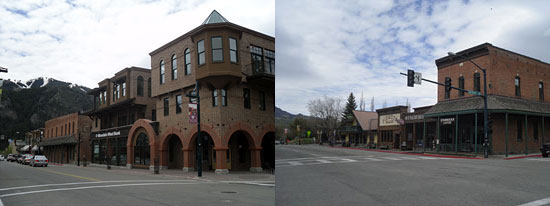 In his own words taken from the opening of "A Farewell to Arms," he wrote: "In the late summer that year we lived in a house in a village that looked across the river and the plain to the mountains. In the bed of the river there were pebbles and boulders, dry and white in the sun, and the water was clear and swiftly moving and blue in the channels. Troops went by the house and down the road and the dust they raised powdered the trees." That's perfection.
I'm paraphrasing and working off rusting memory, but somewhere Hemingway wrote that all stories end bad, referring to each man and woman's life story. He was right, and his life was no exception. Sad, tragic, one must wonder if in the end it was worth it. I've been privy to some old black and white photos taken near the end of his life; picture a frail, sick old man of 60 who could have passed for 80, holding a shotgun to his shoulder, shooting skeet on skinny legs.
A life of very hard drinking that left him with a corroded liver didn't help, or near-death plane wrecks, or bouts of paranoia that haunted him believing the government was out to get him, which it probably was, or the confusion and disorganization Hotch attested to. The doctor cut him back to a couple of glasses of red wine a day which must have been pure hell, those happy days gone for good.
His eyes were failing him, his wonderful words evaporating. He had heart disease and suffered from hypertension and to make matters so much worse, he was electrocuted many times at the Mayo Clinic in Minnesota in hopes that a little misguided current would snap him out of it, whatever it was that tormented the man who was dying inwardly, emotionally, his mind unraveling, boxing that "black-#” hell he wrote of that kept him up at night.
In his own words taken from the opening of "A Farewell to Arms," he wrote: "In the late summer that year we lived in a house in a village that looked across the river and the plain to the mountains. In the bed of the river there were pebbles and boulders, dry and white in the sun, and the water was clear and swiftly moving and blue in the channels. Troops went by the house and down the road and the dust they raised powdered the trees." That's perfection.
I'm paraphrasing and working off rusting memory, but somewhere Hemingway wrote that all stories end bad, referring to each man and woman's life story. He was right, and his life was no exception. Sad, tragic, one must wonder if in the end it was worth it. I've been privy to some old black and white photos taken near the end of his life; picture a frail, sick old man of 60 who could have passed for 80, holding a shotgun to his shoulder, shooting skeet on skinny legs.
A life of very hard drinking that left him with a corroded liver didn't help, or near-death plane wrecks, or bouts of paranoia that haunted him believing the government was out to get him, which it probably was, or the confusion and disorganization Hotch attested to. The doctor cut him back to a couple of glasses of red wine a day which must have been pure hell, those happy days gone for good.
His eyes were failing him, his wonderful words evaporating. He had heart disease and suffered from hypertension and to make matters so much worse, he was electrocuted many times at the Mayo Clinic in Minnesota in hopes that a little misguided current would snap him out of it, whatever it was that tormented the man who was dying inwardly, emotionally, his mind unraveling, boxing that "black-#” hell he wrote of that kept him up at night.
 Christopher Martin, in his book "Ernest Hemingway: A Psychological Autopsy of a Suicide," concluded that my favorite author was a bipolar alcoholic who suffered traumatic brain injury and who had borderline and narcissistic personality traits. Martin claims suicide was inevitable because Hemingway "suffered from an enormous burden of psychiatric comorbidities and risk factors for suicide," although diagnosis was problematic absent a clinical evaluation of Mr. Hemingway. It didn't help that suicide ran in the family and he might have had a genetic defect called hemochromatosis which can lead to physical and mental deterioration.
Given all that it's no wonder that Ernest Miller Hemingway took that final, dreadful step at his home in the early morning hours on July 2, 1961 and marched over to his gun cabinet and loaded his twelve-gauge shotgun and stuck the barrel in his mouth and .....
Christopher Martin, in his book "Ernest Hemingway: A Psychological Autopsy of a Suicide," concluded that my favorite author was a bipolar alcoholic who suffered traumatic brain injury and who had borderline and narcissistic personality traits. Martin claims suicide was inevitable because Hemingway "suffered from an enormous burden of psychiatric comorbidities and risk factors for suicide," although diagnosis was problematic absent a clinical evaluation of Mr. Hemingway. It didn't help that suicide ran in the family and he might have had a genetic defect called hemochromatosis which can lead to physical and mental deterioration.
Given all that it's no wonder that Ernest Miller Hemingway took that final, dreadful step at his home in the early morning hours on July 2, 1961 and marched over to his gun cabinet and loaded his twelve-gauge shotgun and stuck the barrel in his mouth and ..... View Comments
John Treadwell Dunbar is a freelance writer